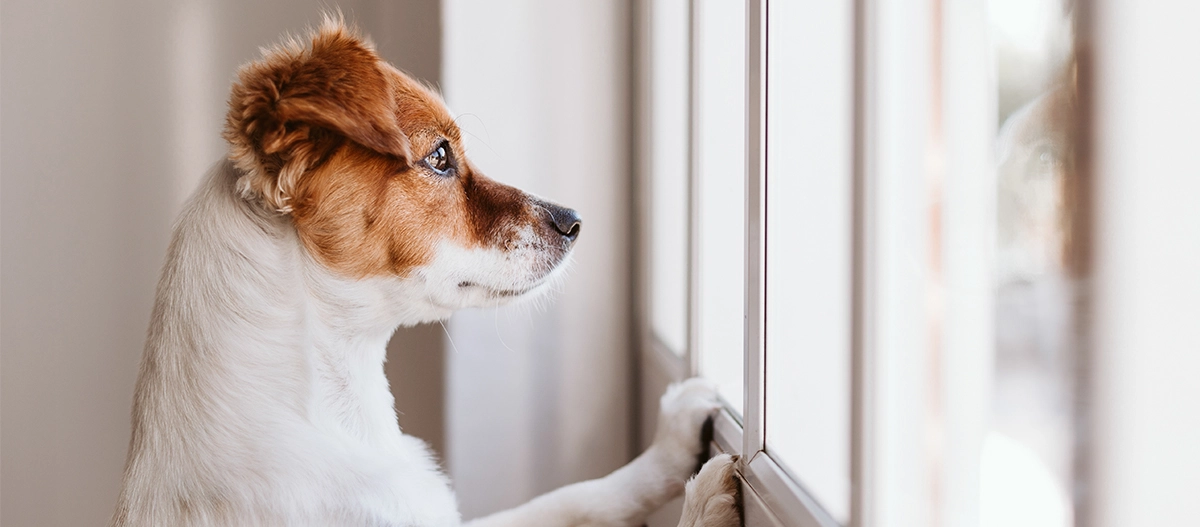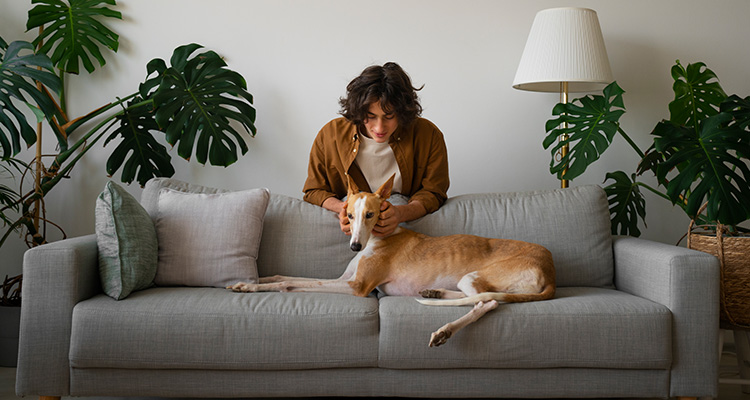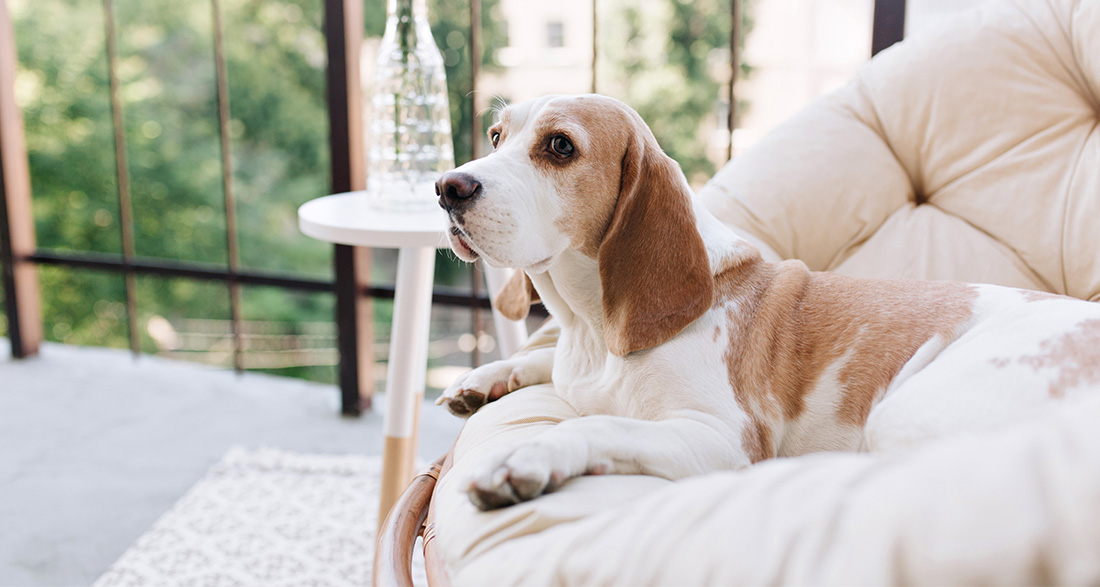Dogs are pack animals. Being alone means being left behind and expelled from the pack for them. Therefore, all dogs fear being alone. However, dogs of all ages can learn to be alone. It’s relatively uncomplicated for puppies, while older dogs require a lot of training and patience. With these tips, your dog will learn to be alone, survive the separation period unscathed – and so will you!
- Can I leave my dog alone?
- Why dogs don’t like being alone
- How long can a dog be left alone?
- Two basic types of dogs: Separation anxiety or loss of control?
- Early Training: Leaving a Puppy Alone
- Leaving the Dog Alone – Training with Adult Dogs
- Leaving the Dog Alone: Preoccupy Before Leaving
- Practice Makes Perfect
- Leaving the Dog Alone: Have Time and Patience
Can I leave my dog alone?
Dogs don’t like to be alone. But sometimes, it can’t be helped, and we have to leave our dog alone: Whether it’s work, situations where you can’t take your four-legged friend with you, or even brief waits in the car, there are times when the animal has to do without its human for a while.
The good news: You can leave your dog alone because every furry friend can learn to be alone. Find out how here.
Why dogs don’t like being alone
The fear of being alone and abandoned is deep-seated in every dog. Even though dogs are no longer kept in packs like wild dogs or wolves, they remain pack animals. Their social behavior and sense of belonging are highly developed. In a pack, weak or sick animals are simply left behind and often perish in this way.
It’s hardly surprising, then, that our dogs are always keen on staying connected to their “family.” There are exceptions, of course. Working dogs with a clear task can stay alone for longer periods. However, it would be truly appropriate if our dogs either always stayed in the dog pack or with their humans.
How long can a dog be left alone?
There’s no universally applicable answer to this question because dogs, like humans, are unique individuals. Some may start howling when their human closes the door, while others become restless after an hour, pacing nervously around the room, nibbling on furniture, or doing their business in protest within the apartment. Very sensitive dogs may even develop depression if left alone too frequently or for too long.
However, some dogs can easily be left alone for several hours without any separation anxiety. But dogs shouldn’t be alone for more than four to five hours, as your dog needs to relieve itself by then!
Leaving the dog alone: Work
If you leave your four-legged family member alone every day and go to work, you should urgently look for a permanent solution. Leaving a dog alone for five to eight hours every day is not an appropriate way to care for them. Consider hiring a dog sitter or using a doggy daycare. Perhaps there’s even the possibility of taking your dog to work: Many companies allow dogs at work under certain conditions – feel free to ask your employer!
Where to leave the dog alone?
The success of leaving the dog alone also depends on the environment. Never leave your dog alone in an unfamiliar place; always leave them at home or in a familiar environment. It’s essential that they have familiar things around them, such as their bed, a cozy blanket, or a toy.
Two basic types of dogs: Separation anxiety or loss of control?

Dogs that are afraid of being alone can be divided into two types: some suffer from separation anxiety, while others experience a loss of control.
Separation Anxiety
With separation anxiety, it’s indeed being alone that causes fear in your dog. As a dog owner, you take on the role of the alpha, overseeing the situation, deciding what needs to be done, and ensuring the pack’s safety. The animal relies on you and remains calm as long as you are nearby. For less relaxed dogs, the temporary disappearance of their human is a real disaster. Suddenly, the alpha is gone, and the basic trust is shaken.
Common Reasons for Separation Anxiety:
- Dog’s Background: You’ve adopted your four-legged friend from a rescue organization, and you’re not aware of all the details of its past. In the case of former shelter residents, it’s likely that the dog is traumatized by the “loss” of its previous owner.
- Puppyhood Experiences: A dog’s first bond is not with humans but with the mother and littermates. If the foundational trust is disrupted during the imprinting phase, such as through early separation from the dog family, it becomes a reason for anxieties. The dog then tends to “cling” more to its new caregivers.
- Training Errors: Surprisingly, it’s often the owner who inadvertently triggers and encourages separation anxiety in their dog.
Symptoms of Separation Anxiety:
- Grief: The dog often sits behind the door for hours, howling and scratching at doors or walls.
- Inappropriate Elimination: Occasionally, dogs react to separation anxiety with house soiling.
- Submissive Greeting: When the owner comes home, the dog is greeted enthusiastically but in a appeasing and submissive posture.
If the reasons for the dog’s separation anxiety lie in bad experiences with previous owners or in puppyhood, they are understandable and plausible. However, often the human’s behavior plays a central role. Unconsciously, we make the animal feel that separation is significant. Showering the dog with many caresses and comfort intensifies the mood of farewell, escalating tension in the dog. When the pack leader actually leaves the house, the dog exhibits the above-mentioned activities.
Loss of Control
For dogs experiencing a loss of control, it’s the concern or even irritation that you, as their “pack,” are out and about without them – without their ability to watch over you. Because that’s what they perceive as their duty, which they can’t fulfill in this case.
If your furry friend belongs to this type of dog, it’s about clearly establishing the hierarchy in the pack and showing them that you are the number one in the pack. They must accept that you are the leader and decide when you come and go. A dog with a loss of control must learn not to feel responsible for his owner. Check where your dog’s favorite spots are. Are they right behind the front door or high up on the couch? This clearly indicates that he sees it as his duty to control everything in the house. Changing these resting places to less exposed locations can sometimes help.
Symptoms of Loss of Control:
- Destructive Behavior: Sofa cushions, shoes, furniture – household items are preferred targets for destructive behavior. The animal seeks an outlet to express its frustration and anger.
- Excessive Barking: The dog barks to vent its annoyance.
- Overenthusiastic Greeting: Upon returning home, the owner is jumped on enthusiastically, not out of joy but as a “punishment” for their “misbehavior.”
Early Training: Leaving a Puppy Alone
If your dog comes to you at a young age, it’s easy to train the new dog to be alone as it grows older. You can train it. Puppies and young dogs can easily adjust their internal clock to our daily rhythm. The age at which a dog can be left alone varies from dog to dog. It should definitely be house-trained, settled into the home, and feel secure. This usually happens around five months of age.
The earlier your little one learns that being alone is part of everyday life, the easier it will be for them after some time. For more information, check out our guide “Leaving Puppies Alone.”
Leaving the Dog Alone – Training with Adult Dogs
There are various reasons why adult dogs may need to learn to be alone, such as changes in living circumstances or a dog joining a new family. Good to know: Even adult animals can learn – you can teach the dog to overcome separation anxiety.
Leaving the Dog Alone: Preoccupy Before Leaving
Training for an adult dog begins with an extensive play session or a long walk. Engage your furry friend in scent games or frolic on a meadow or in a dog park. Training at a dog park with agility or dog dancing is positively strenuous for the dog and enjoyable for most dogs. Before leaving the dog alone, let them expend their energy. In our guide, you’ll discover more ideas for indoor and outdoor dog games.
Practice Makes Perfect

Start small, leaving the dog alone for only a few minutes initially. Follow this schedule:
Meaningful Exercises:
- Direct your dog to its favorite spot and occupy it with a toy or chew bone, for example.
- While it is distracted and not paying attention to you, leave the room and close the door.
- Then observe whether your dog starts to howl or whine.
- After a few minutes, you can return to the room and reward your dog with a treat. This helps your dog positively associate waiting with your return.
Train with your furry friend every day. Extend the separation time a bit each time if you feel your dog remains calm and composed. After a few practice days, you might be able to run errands nearby. Remember to reward your furry friend with a tasty surprise during the adjustment period.
Treats are indispensable aids in training your dog to be alone, as rewarding is crucial, as always in dog training.
Leaving the Dog Alone: Have Time and Patience
Not all dogs adapt to being left alone quickly and effortlessly. Nonetheless, be patient and consistent: do not return to the room as long as your dog is howling or whining. Otherwise, your dog may associate its howling with your return and may whine longer and louder in the future.
If your dog takes a bit longer to get used to being alone: don’t despair or scold, but also don’t coddle your dog excessively. With consistent daily exercises, your dog will find it easier to be alone – and you, to leave the dog alone. Your furry friend will learn to trust you. Instead of whining, it will greet you joyfully and expect its little reward.
Tip: Don’t make a big fuss when leaving your dog alone: Bid farewell casually and greet them enthusiastically only after a few minutes upon returning home!


